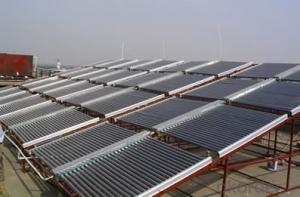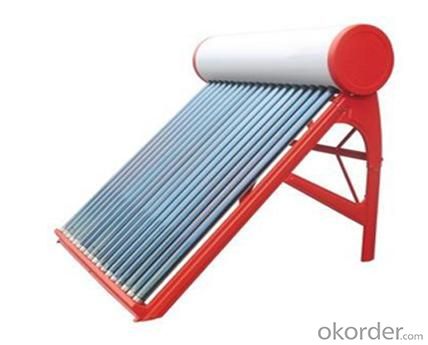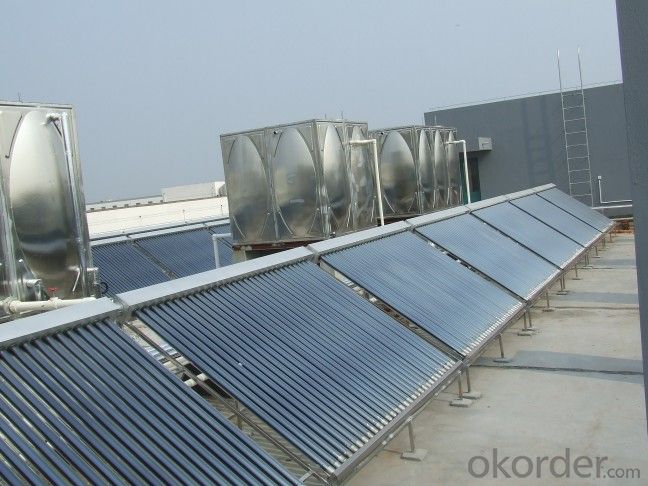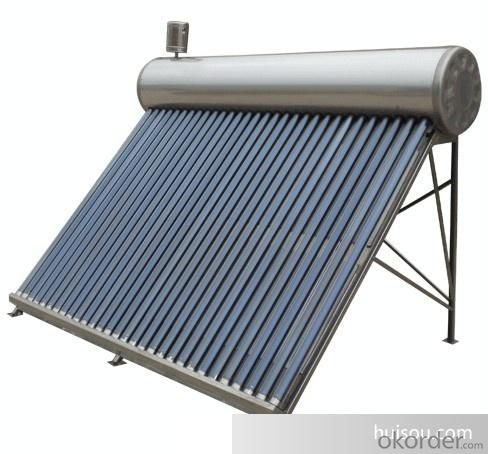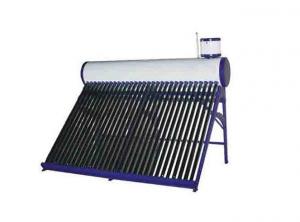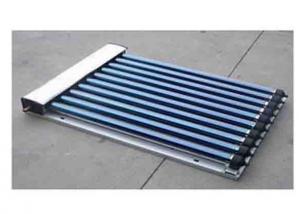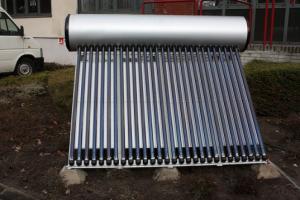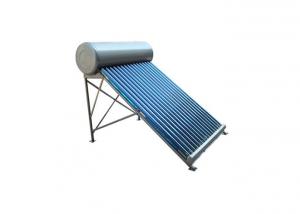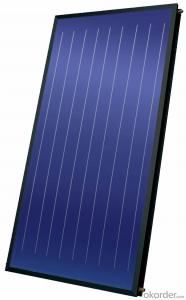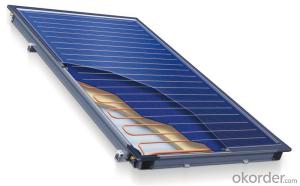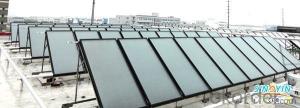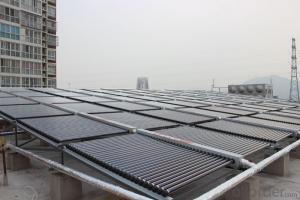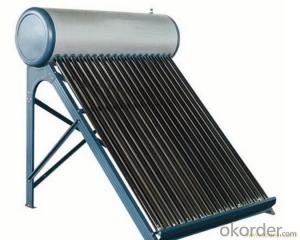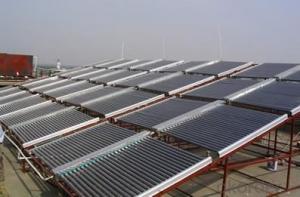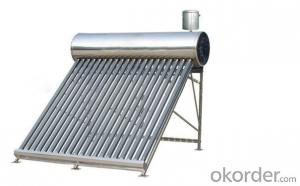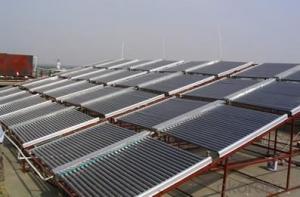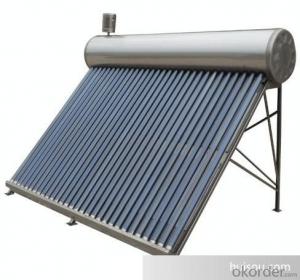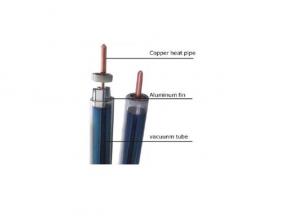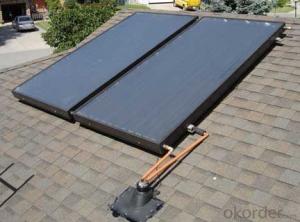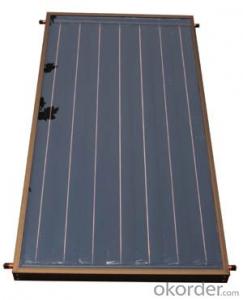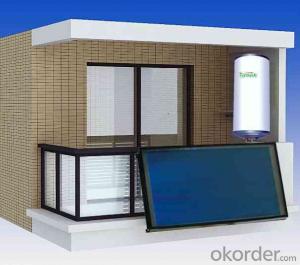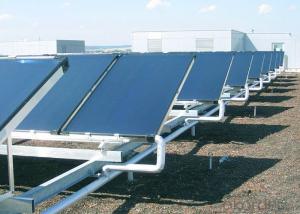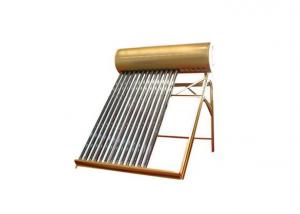Vacuum Solar Collectors Non-Pressurized Heat Pipe Solar Water Heater System 2024 New Design
- Loading Port:
- China main port
- Payment Terms:
- TT OR LC
- Min Order Qty:
- 1 set
- Supply Capability:
- 6000 set/month
OKorder Service Pledge
OKorder Financial Service
You Might Also Like
Introduction of Non-Pressure Solar Water Heater:
Non-pressure Solar Heater is one of the most economical solar water heating device with pretty high efficiency at the same time. It consists of hot water storage tank, solar vacuum tubes with mouth plug in storage tank, and bracket supporting tank and tubes.When cold water in evacuated tubes is heated with solar irradiation, as the specific gravities of hot water and cold water are different, hotter water goes upward to storage tank and colder water goes downward to glass tubes. through this continuous circulation, the cold water in storage tank will be gradually heated till sunset.
Specialty:
1. High thermal performance and working temperature: the heat exchanging rate even in winter can up above 55%.
2. Heat collecting efficiency is at least 20% above common solar systems.
3. Work in all day and all season: no matter any corner of the world, this system can work well even -40℃ to avoid the tube freezing problem.
4. Reliability: No water following through the tube, so water scale can not generate and tube cracks could be avoided, the system still can keep working even with some damaged tubes.
5. It can connect with water tap and work automatically with pressure0.6Mpa, bring enjoyable washing experience.
6. Safety: P/T valve would release pressure and temperature to protect tank..
Technical Specification:
1. Outer tank material: SUS304 stainless steel or powder coated color steel
2. Inner tank material: 1.2mm thick SUS304 food grade stainless steel ( Optional material SUS316L)
3. Vacuum tube material: borosilicate glass 3.3; AL-SS-CU absorb coating, with copper heat pipe inside
4. Frame material: 1.2mm thickness stainless steel
5. Insulation material: 55mm thickness polyurethane
6. Suitable for mains pressure water(up to 8 bar/116psi)
7. Easy plug-in installation
8. Install the T/P valve on the pressurized tank
9. Seal material: Stabilized High Temperature Silicon
Outer tank material: SUS304 stainless steel or powder coated color steel
Inner tank material: 1.2mm thick SUS304 food grade stainless steel ( Optional material SUS316L)
Vacuum tube material: borosilicate glass 3.3; AL-SS-CU absorb coating, with copper heat pipe inside
Frame material: 1.2mm thickness stainless steel
Insulation material: 55mm thickness polyurethane
Suitable for mains pressure water(up to 8 bar/116psi)
Easy plug-in installation
Install the T/P valve on the pressurized tank
Seal material: Stabilized High Temperature Silicon
19. Vacuum Tube | 20. Size (mm) | 21. Φ47*1500 / Φ58*1800 / Φ70*2100 | |||||
22. Tube (pcs) | 23. 10 / 12 / 15 / 18 / 20 / 22 / 24 / 30 / 36 / 42 | ||||||
24. Material | 25. Borosilicate 3.3 glass, magnetron spluttering selective coating | ||||||
26. Coating | 27. Single-target AL-N/AL or Three-target AL/N-Cu-SS | ||||||
28. Water Tank | 29. Capacity | 30. 80L ~ 500L for hot water storage tank | |||||
31. Inner tank | 32. Food-grade stainless steel SUS304-2B / SUS316 | ||||||
33. Insulation | 34. High-density polyurethane foam with 70~80 hour heat preservation | ||||||
35. Tank shell | 36. Food-grade stainless steel SUS304-2B | ||||||
37. Bracket | 38. Shaped strong aluminum alloy structure adaptable for flat or slope roof | ||||||
39. Accessories | 40. Anti-aging silicon seals, Dustproof seals, Air-vent cap, Stainless screws | ||||||
41. Auxiliary Devices | 42. Assistant tank, Intelligent controller, Electrical heater, Magnesium anodes | ||||||
43. Tilt Angle | 44. 25 ~ 50° | ||||||
45. Water Output | 46. 45 - 95°C | ||||||
47. Hail Resistance | 48. Φ25mm diameter | ||||||
49. Model Number | 50. Solar Vacuum Tube | 51. Tank 52. Liter | 53. System 54. Liter | 55. Container Loading Qty /sets | |||
56. Size /mm | 57. Qty /pcs | 58. 20GP | 59. 40GP | 60. 40HQ | |||
61. VNS-58SA12-100 | 62. Φ58*1800 | 63. 12 | 64. 100 | 65. 132 | 66. 58 | 67. 119 | 68. 140 |
69. VNS-58SA15-130 | 70. 15 | 71. 130 | 72. 170 | 73. 54 | 74. 108 | 75. 131 | |
76. VNS-58SA18-150 | 77. 18 | 78. 150 | 79. 198 | 80. 43 | 81. 86 | 82. 105 | |
83. VNS-58SA20-170 | 84. 20 | 85. 170 | 86. 223 | 87. 40 | 88. 80 | 89. 97 | |
VNS-58SA24-200 | 24 | 200 | 263 | 35 | 70 | 85 | |
VNS-58SA30-250 | 30 | 250 | 329 | 28 | 56 | 68 | |
VNS-58SA36-300 | 36 | 300 | 395 | 23 | 47 | 57 | |
Product Show
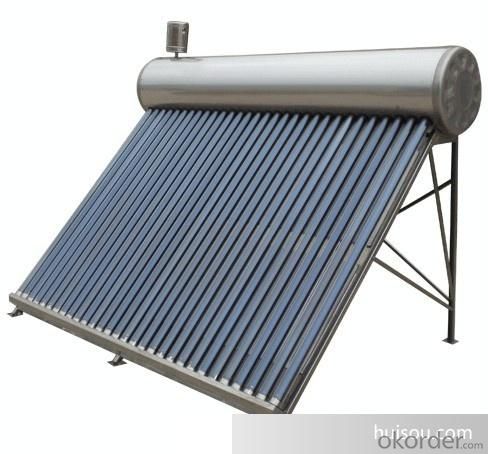
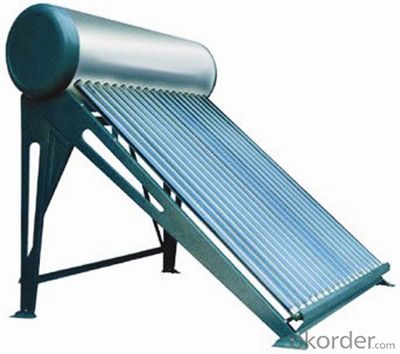
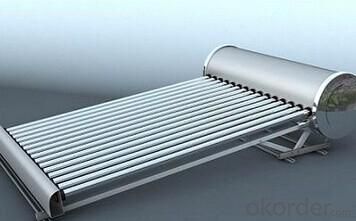
Our Services
1. OEM service
2. Warranty: 5 years
3. Considerable after sale service
Color steel Compact pressure Thermal solar heater
FAQ:
1. What’s the delivery time?
10 days after receiving deposit.
2. How long is the warranty?
5 years for whole system, 1 year for accessory
3. What’s your production capacity?
6000sets/month
4. What’s the MOQ?
1 set.
5. What’s your payment term?
Container: 30% T/T in advance for deposit, 70% T/T before shipment for fist order.
70% T/T after seeing copy of B/L from second order
Sample: 100% T/T in advance
Other choices: L/C at sight.
6. What certifications do you have?
CE, SOLAR KEYMARK, SRCC and etc.
- Q: How do solar collectors perform in hot climates?
- Solar collectors perform well in hot climates as they are designed to absorb and convert sunlight into heat energy. The higher temperatures in hot climates enhance the efficiency of solar collectors, allowing them to generate more heat and provide a greater amount of hot water or space heating.
- Q: How do solar collectors affect the carbon footprint of a building?
- Solar collectors can significantly reduce the carbon footprint of a building by harnessing renewable solar energy to provide power for heating, cooling, and electricity. By utilizing this clean and sustainable energy source, solar collectors help reduce reliance on fossil fuels, thereby reducing greenhouse gas emissions associated with traditional energy generation. This ultimately leads to a lower carbon footprint for the building and contributes to a more sustainable and environmentally friendly future.
- Q: How do solar collectors impact energy independence?
- Solar collectors have a significant impact on energy independence by providing a clean and renewable source of power. By harnessing the sun's energy, solar collectors generate electricity or heat that can be used for various purposes, reducing the reliance on non-renewable sources such as fossil fuels. One of the main advantages of solar collectors is their ability to produce electricity off-grid, allowing individuals, communities, and even entire countries to become more self-sufficient in meeting their energy needs. With solar collectors, remote areas or regions with limited access to traditional power grids can still have a reliable source of electricity, enabling them to become less dependent on external energy sources. Moreover, solar collectors contribute to energy independence by reducing the reliance on imported energy resources. Many countries heavily rely on fossil fuels imported from other nations, which can not only be costly but also subject to political and economic instabilities. By investing in solar collectors, countries can reduce their dependence on such imports, enhancing their energy security and reducing vulnerability to price fluctuations or disruptions in the global energy market. Solar collectors also promote energy independence at the individual level. Homeowners and businesses that install solar panels can generate their own electricity, reducing the need to purchase electricity from the grid. In some cases, excess energy produced by solar collectors can even be sold back to the grid, enabling individuals to become energy producers rather than mere consumers. Furthermore, solar collectors contribute to reducing carbon emissions and combating climate change. By replacing fossil fuel-based electricity generation with solar power, greenhouse gas emissions, such as carbon dioxide, are significantly reduced. This transition to cleaner energy sources not only helps to protect the environment but also reduces the dependence on finite resources that contribute to climate change. Overall, solar collectors play a crucial role in promoting energy independence. By harnessing the sun's energy, they provide a clean, renewable, and reliable source of power, reducing the dependence on non-renewable energy sources, minimizing reliance on imported energy, and contributing to a more sustainable and secure energy future.
- Q: Are there any aesthetic considerations when installing solar collectors?
- Yes, there are aesthetic considerations when installing solar collectors. The placement of solar collectors should be carefully considered to minimize their visual impact on the overall design of the building or landscape. Installers often work to integrate the collectors into the existing architecture or landscape design, using techniques such as flush mounting, color matching, or incorporating them into building materials. Ultimately, the goal is to ensure that solar collectors blend harmoniously with the surroundings and maintain or enhance the aesthetic appeal of the property.
- Q: Can solar collectors be used for generating electricity on shopping malls?
- Solar collectors, such as photovoltaic panels, can be utilized to generate electricity on shopping malls. The installation of these collectors on the rooftops or facades of shopping malls allows them to convert sunlight into electricity. By using this renewable energy source, shopping malls can decrease their reliance on traditional energy sources and reduce their carbon footprint. Moreover, solar collectors offer a sustainable and dependable source of electricity, particularly during peak energy demand periods. Given their large surface areas, shopping malls are ideal locations for solar installations. With the progress in solar technology and the decreasing costs associated with it, an increasing number of shopping malls are adopting solar collectors to produce clean and eco-friendly electricity.
- Q: Can solar collectors be used for heating air conditioning systems?
- Yes, solar collectors can be used for heating air conditioning systems. Solar thermal collectors can capture and convert sunlight into heat energy, which can then be used to heat air or water for air conditioning purposes. This renewable energy source can help reduce the reliance on traditional heating methods, resulting in lower energy costs and a more environmentally friendly solution.
- Q: Can solar collectors be used for generating electricity?
- Yes, solar collectors can be used for generating electricity.
- Q: Can solar collectors be used in data centers?
- Yes, solar collectors can be used in data centers. By harnessing solar energy, data centers can reduce their reliance on traditional electricity sources and lower their carbon footprint. Solar collectors can generate renewable energy to power the data center's operations and provide a sustainable solution for their energy needs.
- Q: Can solar collectors be used for heating emergency response centers?
- Yes, solar collectors can be used for heating emergency response centers. Solar thermal collectors can capture and convert sunlight into heat energy, which can then be used for heating purposes. This renewable energy source can provide a sustainable and cost-effective solution for heating emergency response centers, reducing reliance on traditional fossil fuel-based heating systems and contributing to a greener and more resilient infrastructure.
- Q: The introduction of flat solar water heater
- Flat solar collectors placed in the building bar inside the balcony, windows, roof, walls, make up for the traditional solar water heater due to lack of congenital can not achieve the perfect combination with the building and the environment regret.
Send your message to us
Vacuum Solar Collectors Non-Pressurized Heat Pipe Solar Water Heater System 2024 New Design
- Loading Port:
- China main port
- Payment Terms:
- TT OR LC
- Min Order Qty:
- 1 set
- Supply Capability:
- 6000 set/month
OKorder Service Pledge
OKorder Financial Service
Similar products
Hot products
Hot Searches
Related keywords
